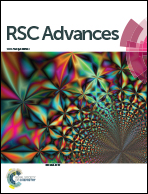Luminescence, energy-transfer and tunable color properties of single-component Tb3+ and/or Sm3+ doped NaGd(WO4)2 phosphors with UV excitation for use as WLEDs†
Abstract
Tb3+ and/or Sm3+ codoped NaGd(WO4)2 phosphors were prepared by a facile hydrothermal process, taking on flower-like microcrystal structures with a mean size of 3 μm. The NaGd(WO4)2:Sm3+ can efficiently absorb ultraviolet light and emit bright blue light from the WO42− group in the host, and has yellow, orange and red emissions from the f–f transitions of Sm3+, due to the host sensitization effect. Under ultraviolet excitation (405 nm), individual Sm3+ ion-activated NaGd(WO4)2 phosphors generate white and red light and the emission intensities reach a maximum at 0.015 equivalents of Sm3+. This is due to the concentration quenching effect, occurring via a resonant-type dipole–dipole interaction, for which the critical distance (RSm–Sm) is calculated to be 21.24 Å. More significantly, in the Tb3+ and Sm3+ codoped NaGd(WO4)2 phosphors, the Tb3+–Sm3+ energy migration has been discussed to occur via a dipole–dipole mechanism. In addition, under different ultraviolet radiation, the color-tunable emissions in NaGd(WO4)2:Tb3+, Sm3+ microcrystals are realized, and this could make them good candidates to be used as full-color phosphors for nUV-LEDs.


 Please wait while we load your content...
Please wait while we load your content...